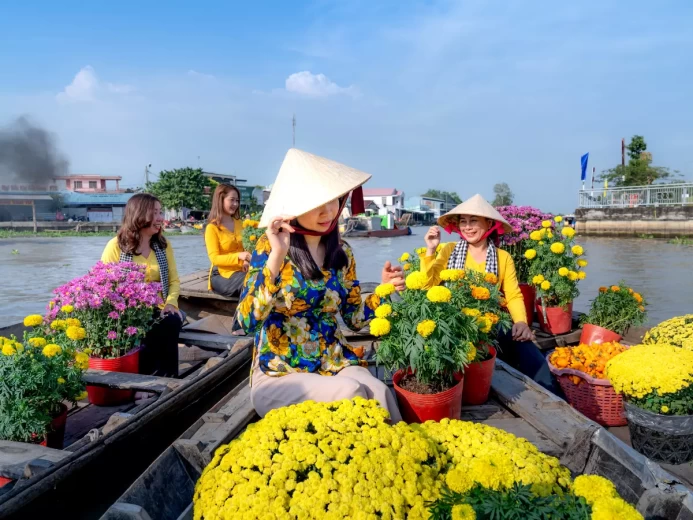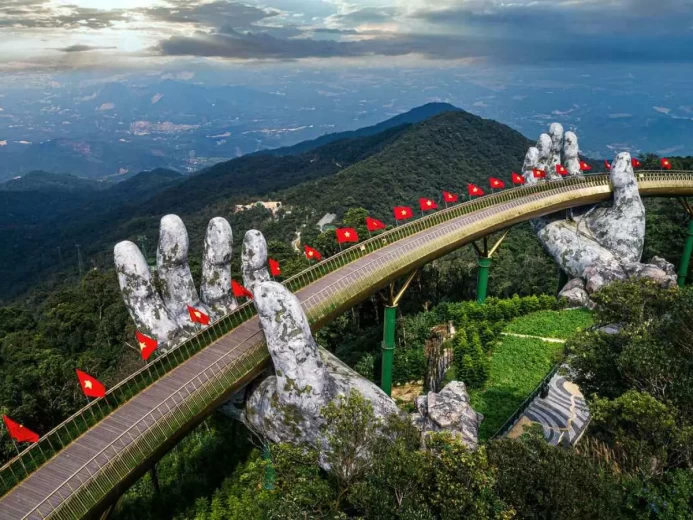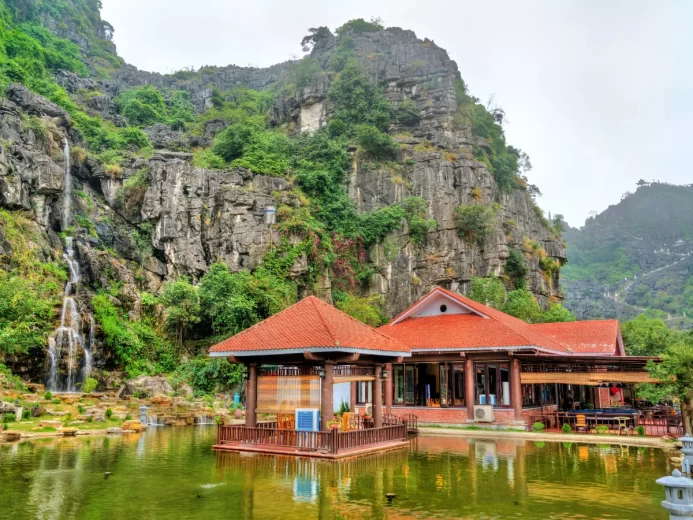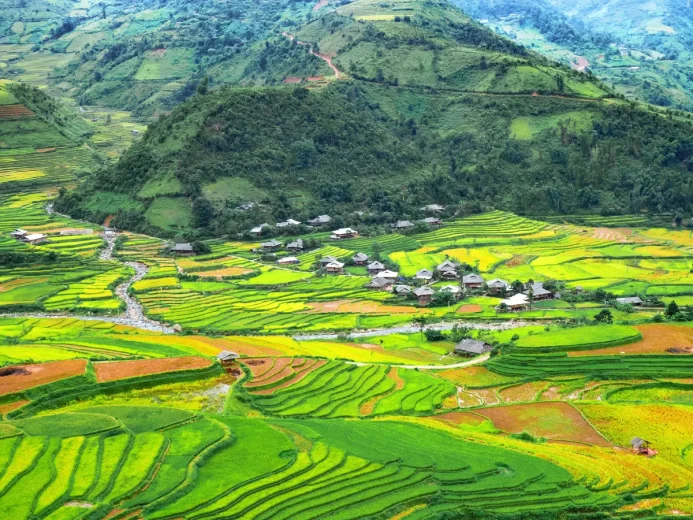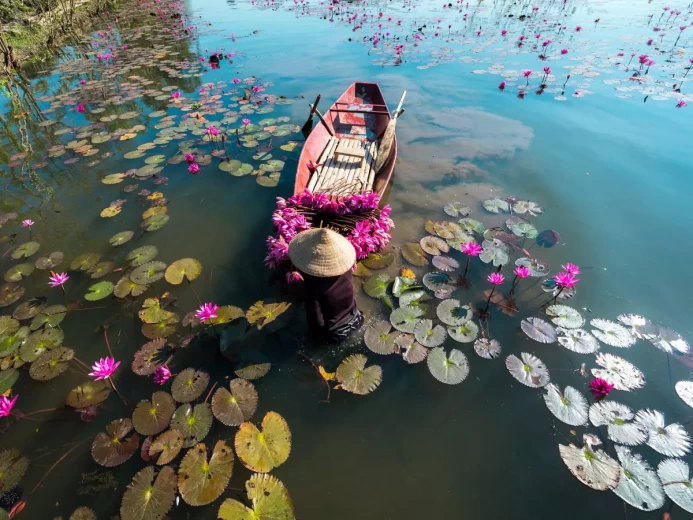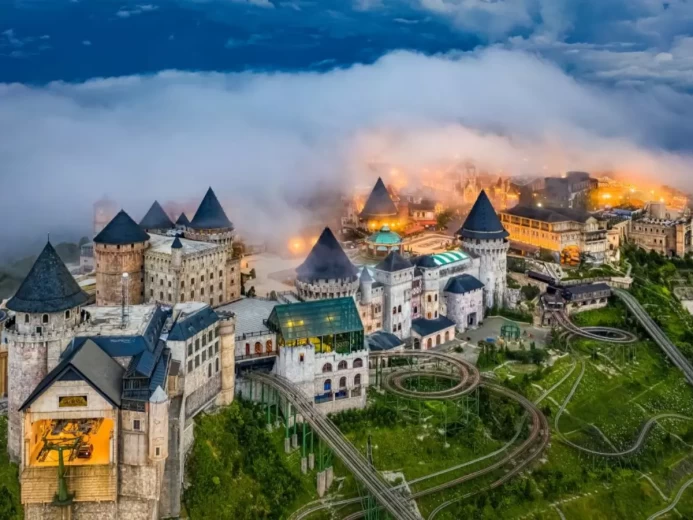About City
Da Nang
"The City of Bridges and Beaches"
Da Nang sits prettily on the east coast of Vietnam, right between Hanoi and Ho Chi Minh City. Popularly known as the tourist capital of South-Central Vietnam, Da Nang is truly stunning - filled with beaches, museums, evolving nightlife and world-class infrastructure.
On the South China Sea coast, with the Han River flowing through its midst, Da Nang is beautified by multiple bridges. Of course, the most striking among them is the Golden Bridge adorned by a sculpture of two giant hands holding it up.
The city’s most famed attractions are The Marble Mountains - five enigmatic natural limestone and marble peaks housing caves, tunnels and temples. Bach Ma National Park, the 693-metre-tall Son Tra Mountain, and Ba Na Hills are popular hiking retreats, while devotees frequent Phap Lam Pagoda and the 67-metre-tall Buddha Shakyamuni statue in Linh Ung Pagoda. For seafood, surfing and kayaking, My Khe Beach, Pham van Dong Beach, Han River and Thanh Binh Beach are perfect relaxing hideouts.
Despite being highly urbanised, Da Nang shelters centuries-old relics of the 700-year-old Phong Nam Village, Con Ga Cathedral, Cao Dai Temple and Imperial City Palace, one of the oldest Vietnamese forbidden cities. Some more must-visit places to make the most of a Da Nang tour are Sun World Wonders, Cham Sculpture Museum, Con Market, and Da Nang Night Market.
Things To Do In Da Nang
1. Golden Bridge
The Golden Bridge, or Cau Vang, located in the Ba Na Hills of Da Nang is famous for its sculpture of two giant hands cradling a golden bridge. The sculpture has acted as a tourist magnet and the bridge is flocked with groups of people strolling or taking selfies. Made up of eight sections, the bridge is about 150 meters long and snakes through the forests of Ba Na Hills.
2. Ba Na Hills
Ba Na Hills is a popular resort complex and hill station located at a height of 1489 meters on the Truong Son Mountains in Da Nang. Also known as Nui Chua, it houses a fantasy park with rides. The Ba Na Cable Car is the longest cable car running on a single track and has been included in the Guinness World Records.
3. My Khe Beach
Stretching for almost 20 miles, My Khe Beach in Da Nang is the most popular beach and for all the right reasons. As far as the eye can see there is silvery-white sand frolicking with blue waters. The beach was awarded by Forbes as being one of the most luxurious beaches in the world. The beach is clean, serene, and tidy, filled with cosy cafes and luxurious restaurants. It is also a prime surfing destination and has prime accommodation facilities. The efforts taken by the Da Nang Lifesaving Association and Da Nang Government has made My Khe a clean, serene, and luxurious getaway.
4. Marble Mountains
Marble Mountains, located just to the south of Da Nang are a cluster of five hills made of marble and limestone. Marble Mountains are highly revered for the Buddhist sanctuaries and other ancient sites found here. Located just off the coastal road, each mountain is said to be dedicated to the 5 natural elements.
5. Dragon Bridge
Dragon Bridge is the largest one in Vietnam and lies over the Han River. The bridge stretches for 1,864-foot-long and was built in July 2009. It currently has a six-lane way for traffic to pass. The bridge is the main connecting link between the Da Nang Airport and the main area of the Da Nang City as well as My Khe and Non-Nuoc Beach.
6. Museum of Cham Sculpture
The Museum of Cham Sculpture is dedicated to Cham Art, displaying an assorted collection of over 300 pieces based on the same. Almost all the artefacts date from the 5th to the 15th century. The Chams were in fact, the indigenous populace of Vietnam. It exhibits sculptures and images of Lingas, Apsaras, Garudas, Brahma, Vishnu, Ganesha and Shiva. Before turning into a museum, this place was known as 'garden of sculptures', and since then, it has been expanded twice. It also consists of collections from My Son, Tra Kieu, Dong Duong, Binh Dinh, Quang Tri and Kon Tum.
7. Hai Van Pass
Hai Van Pass translated to as “ocean cloud pass”, is a 21 km long strip connecting the cities of Da Nang and Lang Co in the Hue Province. Touted to be the highest pass in Vietnam, at a staggering height of 500 metres above sea level, it is a part of the Annamite range which goes down to the East Vietnamese Sea. The exhilarating Hai Van Pass is prominently known for bike rides amidst the mystical view of mountains and clear skies.
8. Son Tra Peninsula
The Son Tra Peninsula lies to the northeastern side of Da Nang and is sprawled across an enormous area of sixty kilometres, bringing in tourists from all over the world. Perched at around seven hundred meters above sea level, this site is perfect for people to take in the breathtaking panoramic views of the quaint Da Nang, and spend a few hours soaking in historical sites and natural beauty.
9. Hoi An
One of the oldest cities in Asia, Hoi An is a town in central Vietnam which was declared as a World Heritage Site by UNESCO in 1999. Located south of Danang, Hoi An translates to 'a peaceful meeting place'. It is culturally and historically one of Vietnam's most important towns and also one of the richest. It is important to note that Hoi An does not have an airport or train station and can only be reached by road.
10. Site Archelogique de My Son
My Son Sanctuary, recognized by UNESCO as the world heritage site, is located about 43km to the southwest of Da Nang. Site Archelogique de My Son is a series of over 70 partly ruined Hindu temples which were built between in the 4th to the 14th century AD by the rulers of Champa.
11. Non Nuoc Beach
Non-Nuoc Beach is moderately populated and is a pristine stretch of sand stretching for about five kilometres along the shore of Hoa Hai Ward at the foot of Ngu Hanh Son. It is a quiet beach with a throng of restaurants serving succulent seafood.
12. Da Nang Cathedral
Danang Cathedral, also known as Con Ga Church (Rooster Church) is a pink-coloured edifice built by French priest Louis Vallet in 1923. It is known as the Con Ga Church after a rooster that tops its bell-tower. Located on Tran Phu Street in Da Nang, the Da Nang Cathedral is the only church in Da Nang which was built during the French Colonial Rule in Vietnam.
13. Pham Lam Pagoda
Formerly known as Tinh Hoi Pagoda, Phap Lam Pagoda is a two-storey Buddhist temple that features a giant gold sculpture of Buddha inside. Belying the hustle and bustle of the Da Nang city, the Phap Lam Pagoda gives you a sense of calm and peace. Built in 1934, the Phap Lam Pagoda is located close to the Con Market and the busiest Ong Ich Khiem street. It features soaring trees and a well-maintained garden where you will find three equally massive Buddha statues.
14. Hot Springs Park
Located around 19 kms south of Da Nang, Hot Springs Park is a water-themed park for kids, friends and families alike against the backdrop of lush vegetation and hills. The park has various rides for all age groups, but the park's highlight is definitely the Japanese-styled hot pools or springs where visitors can sit and relax. There is also a dinosaur-themed section which is popular among kids. A few cafes and restaurants within the park provide guests with food and refreshments, while single and double rooms are available for those who wish to stay for more than one day at the park.
15. Cham Islands
A group of 8 spectacular islands, Cham Islands located off the coast of Hoi An in Central Vietnam, has been garnering much interest since it was declared as a Biosphere Reserve by UNESCO in 2009. The inhabitants of the charming islands are recognized as a distinct community with the entire area being governed by the local Tan Hiep commune.
16. Snorkelling Tour to Cham Island
Discover Cham Island's vivid coral reefs on full-day snorkelling trips from Hoi An and Da Nang into the Cu Lao Cham archipelago, a UNESCO-listed marine biosphere. This beautiful island is surrounded by a sandy beach, dense tropics, and turquoise, year-round warm waters with colourful fish and corals. The best time for snorkelling is between March and September, and one can purchase full snorkelling equipment and hire a guide for only 10 USD on Cham Island.
17. Con Market Da Nang
Con Market happens to be one of the primary markets in Da Nang City that is highly popular for its astounding range of clothing, accessories and handicrafts available at affordable rates. Known alternatively as Da Nang Commercial Centre it is the biggest and busiest retail and wholesale venue in and around the city. It is noted for an array of wholesale goods that are available at heavily discounted prices.
18. Art in Paradise
Art in Paradise, Danang is located a bit off the grid, and that is the charm of this 3D-trick art museum. As you enter the property you will observe more than a thousand 3D artworks vying for your attention. It is acclaimed to be the best 3D Trick art museum in the world where 20 Korean artists have exhibited their skilful pieces, leaving an array of backdrops for you to pose and get clicked.
19. Han River Bridge
Han River Bridge is one of the prime examples of ingenious engineering! It is the first swing bridge in Vietnam and stretches over the Han River for 487 metres. Inaugurated in the year 2000, it not only facilitates transport but also links the eastern side of the river to the city centre. While you are in Da Nang, travel to the bridge at around 11 PM on a weekend when the traffic is stopped and the bridge swings on its axis for about 15 to 20 minutes. to allow the shipping traffic in the Han River to pass through. It is the pride of the Da Nang dwellers and an example of the modernity of the city.
20. Linh Ung Pagoda
Linh Ung Pagoda has the honour of housing the highest statue of Lady Bodhisattva (Lady Buddha) in all of Vietnam, a 67 meters high marvel that sits inside the courtyard of this sanctum. Situated at the far end of Son Tra Peninsula near Da Nang, the majestic Linh Ung Pagoda is a holy sanctuary for millions of devotees who visit this place in large numbers to seek blessings from the supreme power, Buddha. The statue is carved out on a sparkling white marble stone and is one of the many other sculptures of Buddha, and Arhats.
21. Monkey Mountain
The monkey mountain is a formation that juts out of the Son Tra Peninsula, about 12 km from the main city of Da Nang. The monkey mountain resembles a pair of cartoon ears. In the local dialect, it is known as Nui Son Tra but was made popular by the American Soldiers as Monkey Mountain. The monkey mountain is placed at a strategic location with Da Nang on one end and the Hai Van Pass on the other and thus, acted as war base during the US-Vietnam conflict. It was opened to visitors only in the recent past and is now popular as a biking route.
22. Lady Buddha
Lady Buddha is a phenomenal, 67 meters tall white statue that stands high in the Linh Ung Pagoda courtyard in the Son Tra Peninsula in Da Nang. The feet of the Lady Buddha rest on a white Lotus. The left-hand of the Lady Buddha holds the bottle of holy water and the eyes overlook the sea.
23. Da Nang Han River Cruise
Da Nang Han River Cruise is a fiery affair of live music on a river deck with a view of the magnificent Dragon bridge. Travelling in traditional bamboo boats made in Vietnam, you can experience the unforgettable sight of the Fire-Spitting Dragon on the eponymous Dragon Bridge. You can also enjoy languid dinners, refreshing coffees as well as live dance and music shows on the cruise.
24. Han Market
Han Market is a two-storied indoor market, established in the 1940s, Han Market is one of the most happening places in Da Nang. It is like a city centre market with a variety of things available - from fruits and vegetables to clothes, home appliances, you name it and you find it here.
25. Danang Night Market
The duality of Da Nang is a magnificent thing to behold. Even though it is enveloped in a serene aura in the day, it comes to life at night. With pubs, clubs, and markets buzzing with enthusiasm and excitement, Da Nang puts on a whole different attire as the sun goes down, and the stars come out.
26. Da Nang Museum
The museum of Da Nang was earlier located in the Le Duan Street but it shifted to Dien Hai Rampart in 2011. Spread across a display area of 3000 meters square, it marks the first fight of Da Nang soldiers along with various wars and significant historical events. The museum houses a total of 2500 items dating to ethnic groups in Da Nang and Quang Nam and the period of merican takeover of Vietnam.
27. Hoa Nghiem Cave
Hoa Nghiem Caves are a part of the trails on the Marble Mountains in Da Nang. Walking down a small passageway as a part of the Marble Mountain tour, you will enter a massive cavern casing a small Pagoda and a grotto housing statues of Buddha and saints in various positions. Hoa Nghiem Cave makes an interesting visit as it stuns the visitors with beams of sunlight streaming through the holes of the cave roof imparting an ethereal mood to it.
28. Suoi Hoa
Suoi Hoa is an eco-tourism site, situated around 33 kilometres from the city of Da Nang. Suoi Hoa is a part of the quaint Phu Tuc Village in the Hoa Phu commune. Cosseted in rivers, hills, and mountains it is a natural escape worth visiting. Suoi Hoa is also a popular picnic spot with a natural swimming pool, botanical gardens, wildflowers along the trails and myriads of outdoor activities. It is a serene place to rewind and rejuvenate in Da Nang.
29. Van Village Da Nang
Amongst all the places in the vibrant city of Da Nang, the rustic wild Van village is a truly dynamic spot situated at the foot of the Hai Van Pass. Enclosed by Mui Isabella and to the south of Nam Chon Bay, Van Village is known for its lush green forest cover, majestic mountain ranges and calm blue waters. This village is a heavenly place to go trekking and enjoy an amazing sunrise or sunset.
30. Hoa Trung Lake
The rustic beauty of Hoa Trung Lake makes it a famous tourist attraction in the coastal city of Da Nang. Located in the west of Da Nang, the Hoa Trung Lake is a haven for trekkers and nature lovers. It is an artificial lake that supplies water for irrigation and cultivation in the Hoa Lien communes. Popularly referred to as the grassland of Tibet, the scenic Hoa Trung Lake is nestled between mountains and is surrounded by numerous man-made isles.
How to Reach Da Nang
Da Nang is connected with Vietnam and rest of the world by air, land, rail and water.
By flight
Many domestic and international airlines provide service to Da Nang Airport. Some popular airlines are Vietnam Airlines, VietJet Air, Jetstar, China Eastern, etc.
Domestically, Da Nang is connected with all the key cities like Hanoi, Vinh, Can Tho, Da Lat and many others. And internationally, with Beijing, Hong Kong, Macau, Seoul, Tokyo, Singapore and more.
By road
Cabs can be booked from cities like Hue and Hoi An for around 450,000 VND. They can be booked from any taxi services (Mai Linh and Vinasun are few of the goog service providers) or even hotels can arrange one for you.
By train
Da Nang railway station is located at Hai Phong street, 5 km away from the city centre. It is connected with Hue, Hanoi and Saigon via rail network. It's cheaper than the bus for short distances.
By bus
Da Nang bus station is one of the busiest in Vietnam. There are many buses connecting domestically and internationally (Laos) from early morning till late night. Kon Tum, Ho Chi Minh City, Da Lat, Vinh, Hue, Hanoi are few cities from where you can take a bus to Da Nang. Buses run from Laos to Da Nang from Pakse, Savannakhet, Vientiane and Tha Khaek.
Local food in Da nang
One of the best places in Vietnam to discover its eponymous food culture is definitely Da Nang. Da Nang has affordable street-side food in addition to luxury dining options. From the Vermicelli Pork Noodles to Bun Bun Cha (A Local Soup delicacy), from the wholesome Xoi Ga (Sticky Rice with Chicken) to the humble Pho Bo (Beef Soup); there is something for every taste, budget, and appetite here.
Food from North Vietnam: Banh Cuon, Bun Cha, Pho, Xoi, Bun Bo Nam Bo
Food from Central Vietnam: Banh Khoai, Bun Bo Hue, Com Hen, Canh Chua Ca, Banh Mi, Banh Xao, Goi Cuon, Bot Chien, Potato Cakes.
Vietnamese Desserts: Che Chuoi, Che Troi Nuoc, Che Ba Mau, Che Bap, Che Ba Ba.
Traditional Vietnamese Drinks: Sticky Rice Wine, Vietnamese Coffee.
Best Time To Visit Da Nang
The best time to visit Da Nang is from February to May. The rainfall is minimal, with mostly sunny skies and less humidity. The temperature can vary from a low 20°C to a high of 32°C. Due to the minimal rainfall, it is a great time to hit the beaches. Expect to see large crowds of tourists and locals as well, in and around da nang.
During June to August, Da Nang is said to have the most number of domestic tourists flocking in making it its peak season. During this time, you will find all the accommodation and travelling, expensive to this place, so if you’re on budget travel, avoid visiting Da Nang in these months.
The temperature during these months fluctuates between 32-38 degree centigrade, making it comparatively hotter than the other months. You will find most of the tourist attractions overcrowded during these months.
Da Nang in Off Season- October to January
Usually, these months are the months where you’ll find very few travellers, and if you are on a strict tight budget, then you can opt for Da Nang during these months. These months are usually the wet months or the rainy season in Da Nang, out of which December and January don’t face a lot of rainfall. The temperature ranges from 20-30 degree centigrade at this time. If you want to enjoy the beach and enjoy water sports, then these months are not for your visit.

